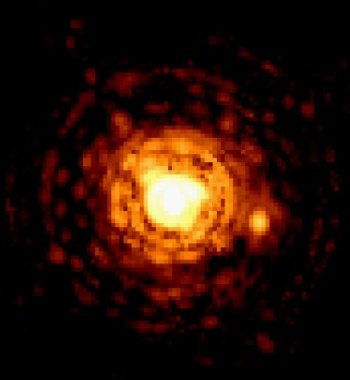About Stars: Red Dwarfs (original) (raw)
Spectral class: M, K
Red dwarfs are the most frequent and most inconspicuous stars in the universe. Red dwarfs have between eight percent and the half of the mass of the Sun and shine in red. The reason for this is their low surface temperature of 2500 - 4000 kelvin.
Red dwarfs live very long, in any case longer than the universe is old now. Therefore they are so numerous. In groups of new born stars they haven't got this frequency, because the bigger stars are all still there.
Many red dwarfs should have planets. But with red light photosynthesis is more difficult and less effective. So life there would have different conditions. Furthermore planets, that are near enough to get sufficient energy, are tidally locked. This means, they show their star always the same side. It is debatable if under such conditions the planet could keep an atmosphere, but if so there would be very strong storms.
Stars aren't quiet on their surface. There are often eruptions, so called flares. Many young red dwarfs are flare stars with frequent and heavy eruptions, increasing their brightness enormously for a short time.
Subdwarfs are very old stars which lie below the main sequence. So they are too dim for their color. The reason for this is that due to their age they contain only very few heavy elements.
Example: Lalande 21185
Back: About Stars | Continue: Yellow and White Stars

A pair of red dwarfs, Gliese 623 A and the tiny B.
Photo: C. Barbieri (Univ. of Padua), NASA, ESA